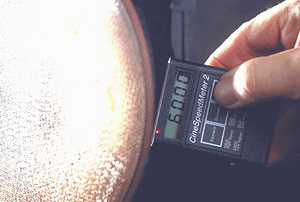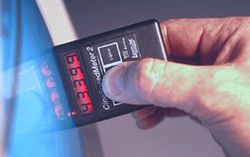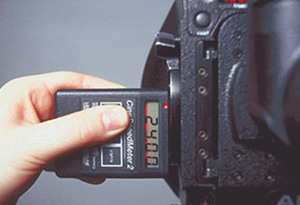
How do I check for light flicker?
How do I check generator frequency?
Why do I get a 60 Hz reading when reading Kino-Flos?
When reading a normal florescent, I get half the mains frequency, i.e. 30 or 25Hz?
How do I check screen scan rates?
How do I check camera frame rates?
Q: How do I check for light flicker?

A: The CineSpeedMeter2 can check for a flickering light source indicating a bad bulb, possible generator or ballast problems. Read the light source as indicated above. A flickering light will give a inconsistent, unsteady display.
Q: How do I check generator frequency?
A: The CineSpeedMeter2 monitors generator frequency by reading the output of most any type of A.C. light source. Just point the CineSpeedMeter2 directly at the source or at the reflected light from a bounce. Press and hold the "Lights" button. It will then display the measured frequency to .01Hz accuracy.
Q: Why do I get a 60 Hz reading when reading Kino-Flos?
A:: Although Kino-Flos operate at high frequency (25kHz typical), there is a slight bleed through of the 60 Hz line frequency. Though the bleed through is far below any noticeable variation in light output, the internal circuitry of the CineSpeedMeter is sensitive enough to pick it up. The 25kHz operating frequency is far above the input response of the meter therefore, it displays the 60Hz bleed.
Q: When reading a normal florescent, I get half the mains frequency?
A: When measuring a florescent light, you must read from as close to the center as possible. A florescent light works by discharging light from alternating ends. One end discharges on the positive voltage half-cycle and the other end discharges on the negative voltage half-cycle. Together they add up to 60Hz. Typically, when a florescent light starts flickering, one of the electrodes have gone bad which means the light is only firing on one side, i.e. 30Hz.
Q: How do I check screen scan rates?

A: The CineSpeedMeter2 can read screen scan rates to .001Hz accuracy. Simply place the CineSpeedMeter2 directly against the screen, press and hold the "Screens" button. Once the scan rate is determined, the user can then apply that value to any camera speed control unit, thereby locking the video roll bar in place during filming. Make sure the face of the CineSpeedMeter is flush against the screen, as any stray light from an AC source will make the meter give erroneous results. If possible, shield all direct light from hitting the area of the screen you are reading. The light will enter through the 1/8" glass and bounce back off of the screen phosphor into the meter. The screen MUST have a steady, non-moving display. Temporarily, turn the screen brightness up for maximum signal to the meter.
Q: How do I check camera frame rates?
A: The CineSpeedMeter2 can also check camera frame rates, thereby giving you a visual indication of the steadiness and accuracy of the camera motor. To perform a camera speed test, first remove the lens. Shine a suitable light into the eyepiece. Turn the camera on. Align the red marker spot on the CineSpeedMeter2 with the center of the camera port. Once aligned, press and hold the "Camera" button. The camera frame rate will be displayed to .01FPS accuracy.
The measurement can also be performed with the lens still in place. For best results, make sure there are no AC light sources shining into the port or eyepiece (i.e. overhead room lights). Because of the precise way the CineSpeedMeter takes measurements, you may see the frame rate alternate slightly around the desired frame rate. This is due to the way camera motor electronics work. Most motor electronics work on a direct "feedback" system. The main steps are:
1) The motor starts spinning and feeds pulses to the control electronics.
2) Control electronics counts the pulses and sends a signal to either speed up or slow down the motor.
3) The motor speed either increases or decreases. The motor continuously sends pulses to control electronics.
4) Control electronics counts pulses and sends signal to either speed up or slow down the motor.
5) The motor speed either increases or decreases. The motor continuously sends pulses to control electronics.
6) So on and so on.
The motor doesn't really run at EXACTLY 24.000 frames. It bounces between say 23.999 and 24.001, with the average being 24.000, as an example. It could be more or it could be less. How fast the control electronics and motor correct themselves is what determines how precise the camera unit is.
